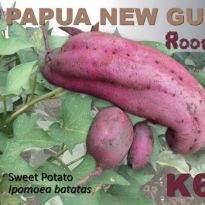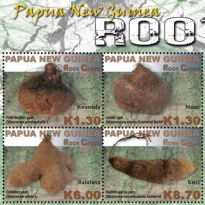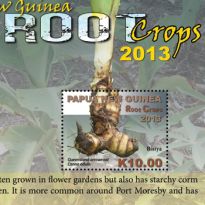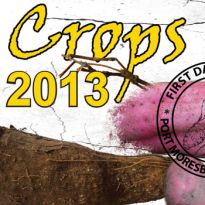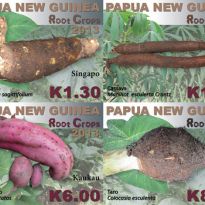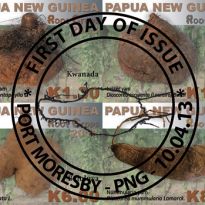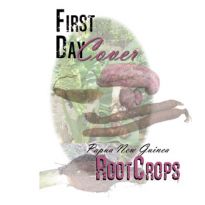Root Crops - Papua New Guinea
2013 Releases
Root Crops - Papua New Guinea
Root crops in this issue are referred to plants with tubers that yield underground and are edible to most Papua New Guineans.
Despite been introduced to western foods, the mass of the population rely heavily on root crops such as yams, taro, cassava and sweet potatoes to survive.
The recently introduced English potato (Solanum tuberosum) though, is another root crop that is rapidly gaining popularity along other local crops.
Root crops are commonly found in most local markets in Papua New Guinea. Depending on the climate and suitability of soil for cultivation, where these crops are abundantly found, they become common food to the habitants. To have a surplus of any one kind (root crop) is a symbol of wealth. As high regard as that of yams by the Trobriand Islanders, same is accorded for taro, cassava and sweet potato by others.
One cannot marry without yams, one cannot build a trading canoe without yams, one cannot build a house without yams, one cannot bury the dead without yams and one cannot conduct ceremonies without yams. They are a commodity with a high regard and value.
Yams, when harvested, are stored away in yam houses for as long as 6 months. The other crops, though are just as valuable, however, are not suitable for preservation for longer period of time. Most go stale one week after harvest.
Root crops can be cooked over a fire, boiled, steamed or dried. Some can either be eaten boiled or raw, depending on how, one wants to enjoy them. Featured in this issue are some of the root crops that are found in Papua New Guinea.
STAMP SET
K1.30 - 'Manihotesculerta Crantz Large tropical woody shrub with enlarge tuberous roots found in every parts of Papua New Guinea
K1.30 -Xanthosoma sagittifolium The method is the same as the colocasia esculenta taro. It is found nearly in every parts of Papua New Guinea.
K6.00 - Ipomoea batatas Though,Sweet Potato is found in every Province, it is a common food to the Highlanders of Papua New Guinea. It can be cooked or eaten raw.
K8.70 - Colocasia esculenta Taro is found nearly in every Province of Papua New Guinea. They can be cooked over a fire, boiled or steamed in a mumu pit.
RETAIL PRICE K17.30
SHEETLET
K1.30 - Kwanada (Five leaflet yam) Dioscorea pentaphylla L
K1.30 - Mami (Lesser yam) Dioscorea esculenta (Loureiro) Burkil
K6.00 - Baluluva (Greater yam) Dioscorea alata L.
K8.70 - Kuvi (Nummularia yam)
RETAIL PRICE K17.30
SOUVENIR SHEET
K10.00 - An Invasive Indo-Pacific lionfish (Pterois). Native to the tropical Indo-Pacific region, lionfish are often kept in both public and private aquariums.
Technical Details
- Stamp Size
- 40mm x 30mm
- Souvenir
Sheet Size - 86mm x 116mm
- Sheetlet Size
- 86mm x 116mm
- Denomination
- K1.30, K1.30, K6.00 & K8.70
- Sheet Contents
- 25 stamps
- Format
- Horizontal
- Perforation
- 2mm
- Colours
- 4 colour Process
- Paper
- Tullis Russel Non Phosphor
- Gum
- Unwatered mark, PVA Gummed
- Printing Technique
- Multicolour Offset, Lithography
- Designer
- Billy John Telek - Post PNG Philatelic Production
- Printer
- Henan Post Printer - China
- Issue Date
- 10th April, 2013
- Withdrawal Date
- 10th October, 2013

